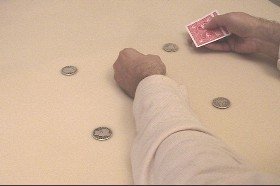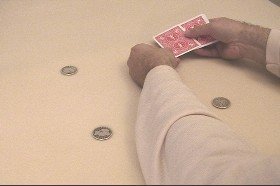| pressing your finger on the tape several times to reduce its power so the card can be |
| unstuck from the coin a little easier. |
| In this version of the transfer sequence, the left hand moves the cards to the table while |
| the right holds the cards, dealing them off one at a time. In so doing the right hand |
| fingers pick up and deposit a coin achieving the first necessary transfer. Using both |
| hands in this way is easier to do than with one hand. However, part of the idea in the |
| classic version is that dealing the cards with one hand gives the audience the illusion |
| that you are simply setting the props on the table. The method presented here is not |
| quite as free as the one hand method. However, it is very close. Place four coins on |
| the table in a rectangular array. Hold four cards in dealing position in the right hand. |
| Move the cards in the right hand along with the left hand to the upper right position. |
 The cards in the right hover over the coin there while the right thumb pushes The cards in the right hover over the coin there while the right thumb pushes |
off a single card. The left hand grasps the card  and places it on the coin. The and places it on the coin. The |
| right hand moves to the right allowing the top card to fall on the coin. Then both hands |
move to the lower right coin.  Again the right hand hovers near the coin there. Again the right hand hovers near the coin there. |
| Also once again, the right hand thumb pushes the top card to the left. The left hand |
| grasps the top card to place it over the coin on the table. At this point, however, the |
|
|    |


